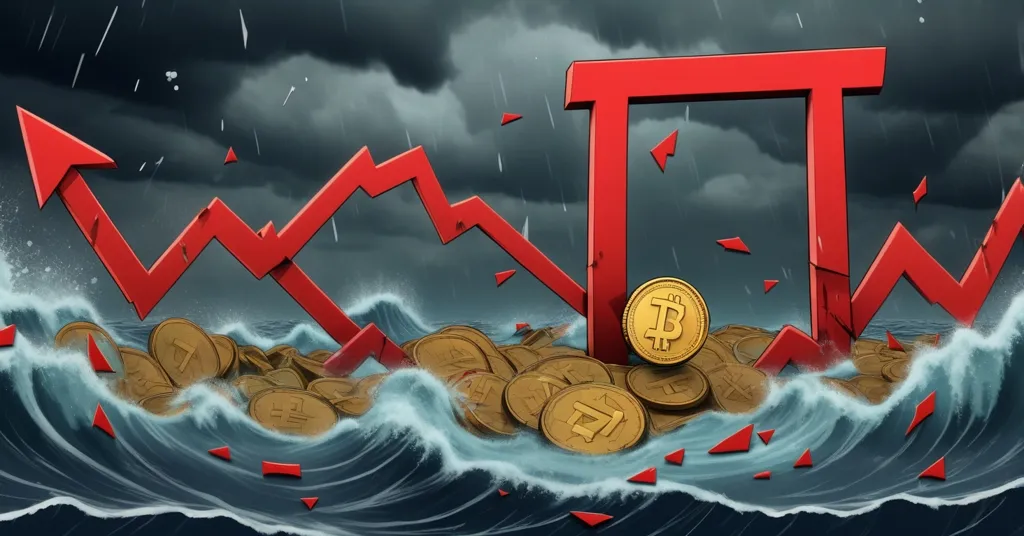Pi Coin Crashes to New Lows as CEX Supply Surges and Trading Volume Collapses

Pi Coin Sinks to New Lows: CEX Supply Explodes While Trading Volume Crashes
Pi Network (PI), the altcoin once heralded as a game-changer with its mobile mining pitch, is hitting rock bottom. A staggering 30% surge in tokens held on centralized exchanges (CEXs) paired with a catastrophic 90% drop in trading volume has analysts sounding the alarm over massive sell-side pressure. As the Pi community—known as Pioneers—clings to pie-in-the-sky value dreams, frustration with the Core Team mounts, and the market paints a grim picture for this beleaguered project.
- CEX Supply Boom: PI tokens on exchanges spiked from 263 million to 346.8 million by mid-June 2025, a 30% jump in just three months.
- Volume Meltdown: Weekly trading volume cratered from $5.4 billion in May to under $500 million, a drop of over 90%.
- Community Unrest: Large Pi Foundation wallet moves stir fears of oversupply, while Pioneers grow weary of stalled progress.
Supply Surge: A Ticking Time Bomb for PI
The numbers don’t lie, and they’re brutal for Pi Network. On-chain data tracked by platforms like Piscan reveals that the stash of PI tokens on centralized exchanges has ballooned to 346.8 million as of mid-June 2025, up from 263 million in March. That’s a 30% increase in just three months, translating to a cumulative value of about $187.9 million at the current price of roughly $0.62. Gate.io holds the lion’s share with 163.2 million tokens, followed by Bitget at 118.5 million, and OKX with 28.5 million. For the uninitiated, a high supply on CEXs often means tokens are primed for trading—or more ominously, for selling. This buildup, often called sell-side pressure, can tank a coin’s price if buyer demand can’t keep up, as sellers flood the market with more tokens than anyone wants to snatch up. For more details on this alarming trend, check out the analysis of PI token supply growth on CEXs.
Despite some short-term relief with a 24-hour net outflow of 1.13 million PI—where 8 million were deposited and 9.2 million withdrawn—the overall trend is damning. Outflows from major exchanges like OKX (741,272 PI), Bitget (171,036 PI), and Gate.io (over half a million PI) suggest some holders are moving tokens to private wallets, potentially a sign of long-term faith. But let’s not kid ourselves: the total supply on CEXs keeps climbing, meaning inflows are outpacing these withdrawals over time. As one observer, Investor Moon Jeff, bluntly noted on X:
“The only consistent thing about PI is the increasing number of coins in exchanges.”
This relentless accumulation hints at a market on the brink. With $187.9 million worth of PI sitting on trading platforms, even a modest wave of selling could overwhelm the sparse buyer interest, dragging the price further into the abyss. Analysts are already waving red flags, with some predicting a nosedive to $0.1 if sentiment doesn’t flip—though a rebound to $1.7 isn’t impossible if Bitcoin and the broader crypto market stage a comeback. For deeper insights into how this affects PI’s market dynamics, see this report on CEX supply surge impact on PI price.
Trading Volume Collapse: No Fuel Left in the Tank
If the supply surge wasn’t bad enough, PI’s trading volume has utterly imploded. According to CoinMarketCap data, weekly volume has plummeted from a hefty $5.4 billion in May to a measly sub-$500 million in the latest figures for June 2025—a gut-wrenching drop of over 90%. To put this in perspective, trading volume reflects how much a cryptocurrency is being bought and sold; high volume often means strong liquidity and price stability, while low volume signals a fragile market where even small trades can cause wild swings. Curious about the reasons behind this decline? Explore this discussion on causes of PI trading volume drops. As community member @pinetworkmember lamented on X:
“The strength and power to go up is gone with an always decreasing trading volume.”
This isn’t just a rough patch—it’s a flashing neon sign of waning investor interest. Without enough trading activity to absorb the growing supply on exchanges, PI is a sitting duck for sharp declines. The correlation with Bitcoin’s price movements can’t be ignored either; when BTC dips, altcoins like PI often take a disproportionate beating as risk-averse investors flee to safer assets. In the harsh 2025 crypto market, where Bitcoin dominance looms large, speculative projects are bleeding out, and PI’s shrinking volume is a textbook case of fading hype meeting cold, hard reality. Community perspectives on this BTC correlation are captured in this Reddit thread on PI volume and Bitcoin price trends.
Foundation Moves: Transparency Crisis or Strategic Play?
Now let’s zero in on a major source of anxiety for the Pioneer community: the Pi Foundation’s wallet activity. The Foundation and its associated addresses hold a staggering 72.5 billion PI tokens, valued at $39.3 billion at current prices, though most of this hoard remains inactive. Recently, though, some eyebrow-raising transactions have set tongues wagging. One wallet (address GBQQRIQK…HJI25) offloaded 50 million PI in a single move with no incoming tokens to balance it out. Another (GAB7TEMP…4GC5G) showed a net positive flow of 43 million PI. Are these liquidity injections for partnerships or exchange listings, or are we witnessing the early rumblings of a dump? With zero clarity from the Core Team, speculation is running wild. For more on this unsettling activity, see this analysis of Pi Foundation wallet outflows.
For those new to the space, large wallet movements by project founders or foundations often spook investors, especially in altcoins with already shaky trust. Oversupply fears kick in—too many tokens hitting the market at once can crater the price, as demand struggles to match. With the Foundation controlling such a massive stash, the centralized nature of PI’s token distribution flies in the face of the decentralization ethos we champion. It’s a bitter irony for a project that promised to democratize crypto, and Pioneers are understandably rattled by the opacity surrounding these moves.
Token Unlocks: More Fuel for the Fire
As if the current supply woes weren’t enough, upcoming token unlocks are poised to pour more oil on this dumpster fire. Data from BeInCrypto points to 337 million PI tokens scheduled for release into circulation over the next 30 days. For the unversed, token unlocks are pre-planned events where previously locked-up tokens—often held by founders, early investors, or for project development—are freed up for trading or sale. When these hit the market, the increased supply can crush prices if demand doesn’t spike to match. For PI, already staggering under CEX supply pressure and dwindling volume, this is a recipe for further pain. Past altcoin projects have seen price implosions post-unlock—think Terra Luna before its collapse—and PI risks following a similar script unless the Core Team pulls off a miracle. Dive into further details with this 2025 analysis of PI token supply challenges.
Community Rift: Dreams vs. Despair
At the heart of Pi Network is its community of Pioneers, a dedicated user base that bought into the 2019 vision of accessible crypto mining via smartphones. Founded by Stanford grads Dr. Nicolas Kokkalis and Dr. Chengdiao Fan, PI promised a currency anyone could mine without fancy hardware, amassing millions of users worldwide. Yet years later, with over 4 billion PI in circulation and a mainnet launch mired in delays, the cracks are glaring. Pioneers fixate on a speculative Global Consensus Value (GCV) of $314,159 per token—a community-driven dream price that ignores the harsh market reality of sub-$1 trading. It’s a charming, if delusional, act of faith. Community sentiment on price trends is further explored in this Reddit discussion on PI’s CEX supply and price.
But beneath this hope lies deep frustration. Many Pioneers refuse to buy more tokens until the Core Team shows real progress—be it a functioning mainnet, clear utility, or transparency on tokenomics. The disconnect between hype and delivery is palpable, echoing countless altcoin sagas where promises of mass adoption fizzle out. Still, there’s a flicker of resilience here; some argue this loyal base could be PI’s lifeline if a breakthrough ever lands. But let’s not sugarcoat it—blind faith won’t prop up a token when market indicators scream bearish, and the clock is ticking.
Pi Network 101: What’s the Big Deal?
For newcomers, let’s break down what Pi Network even is. Launched in 2019, PI aimed to disrupt traditional crypto mining by letting users earn tokens through a smartphone app, no energy-hogging rigs required. The idea was to make digital currency accessible to the masses, a noble stab at disrupting financial gatekeepers. But the execution? Messy at best. With billions of tokens circulating or hoarded by the Foundation, delayed rollouts of a fully decentralized network, and no killer use case, PI has become more of a speculative gamble than a revolutionary tool. It’s a stark contrast to Bitcoin’s proven store-of-value status or Ethereum’s smart contract utility, and a reminder that good intentions don’t guarantee market success. For a quick overview, take a look at this background on Pi Network.
Big Picture: Altcoin Reckoning in 2025
Zooming out, PI’s plight isn’t an isolated debacle—it’s a microcosm of the broader altcoin struggle in 2025. With Bitcoin reasserting dominance and regulatory headwinds battering speculative projects, many altcoins are floundering. PI shares DNA with other overhyped tokens—think Terra Luna before its notorious implosion—where centralized control, delayed deliverables, and shaky tokenomics erode trust. Regulatory scrutiny could be the next shoe to drop; jurisdictions like the US (via the SEC) or the EU might classify PI as a security if utility remains elusive, slapping it with compliance burdens or outright bans. For every Ethereum carving out a niche, dozens of PIs litter the crypto graveyard, unable to convert hype into substance. For a broader take on PI’s current standing, read this report on PI coin hitting new lows.
As Bitcoin maximalists, we can’t help but smirk at altcoins that overpromise while betraying decentralization with founder-held stashes. Yet, we acknowledge the spark of innovation in PI’s mobile mining concept—it aimed to lower barriers, aligning with our push to disrupt the status quo. The problem is execution, or lack thereof. Could the Core Team pivot to a niche like microtransactions or gamified rewards to build real utility? Possibly. But without swift action, upcoming token unlocks and sell pressure might bury PI before it gets the chance.
Regulatory Risks: The Looming Storm
One underexplored threat to PI is the specter of regulation. Altcoins with murky utility and centralized holdings are increasingly in the crosshairs of global watchdogs. In the US, the SEC has cracked down on tokens deemed unregistered securities—think Ripple’s XRP legal saga. If PI’s Core Team can’t prove tangible use beyond speculation, it risks similar scrutiny, especially with 72.5 billion tokens under Foundation control. Across the pond, the EU’s MiCA framework is tightening rules on crypto issuers, demanding transparency PI currently lacks. A regulatory slap could kneecap adoption or scare off exchanges, adding another layer of pain to an already bruised project. It’s a harsh reminder that in the push for decentralized freedom, navigating the old guard’s rules remains a bitter necessity.
Historical Hype: From Promise to Pitfall
To understand PI’s current mess, a quick look at its past is telling. At launch in 2019, it rode a wave of excitement, promising post-mainnet prices as high as $65, per early community buzz on platforms like Reddit. User growth exploded, with millions downloading the app to mine free tokens. But mainnet delays—still ongoing in 2025—shattered timelines, and the price languished below $1, a far cry from those lofty projections. This cycle of hype followed by disappointment mirrors countless altcoins that bank on user numbers over utility. PI’s story is a cautionary tale: community size means little if the tech or tokenomics don’t hold up under market scrutiny.
Key Takeaways and Questions on Pi Network’s Downward Spiral
- What’s driving the explosion of PI tokens on centralized exchanges?
A 30% surge to 346.8 million tokens by mid-June 2025, despite daily net outflows of 1.13 million PI, points to sustained inflows—possibly from holders or the Foundation—setting up potential sales. - Why has PI’s trading volume tanked so hard?
A 90%+ drop from $5.4 billion weekly in May to under $500 million reflects fading investor interest, bearish sentiment, and Bitcoin’s drag on altcoin markets in 2025. - How does the rising CEX supply threaten PI’s price?
With $187.9 million in PI on exchanges and weak buyer demand, even small sell-offs could trigger steep drops from $0.62, with analysts warning of a possible slide to $0.1. - What’s behind the unease over Pi Foundation wallet transactions?
Moves like a 50 million PI outflow, with 72.5 billion tokens ($39.3 billion) in Foundation hands, spark oversupply fears and distrust due to the Core Team’s lack of transparency. - Why are Pioneers obsessed with a Global Consensus Value of $314,159?
This speculative target embodies community faith in PI’s potential over its sub-$1 reality, though frustration with stalled progress reveals a widening gap between hope and results. - Could token unlocks worsen PI’s struggles?
With 337 million PI set for release in 30 days, added supply could further crush prices, especially given existing pressure and low liquidity, risking a market implosion. - Is there any hope for Pi Network’s recovery?
A mainnet launch or pivot to real utility (like microtransactions) could spark a turnaround, but delays, centralization, and market headwinds make it a long shot without drastic Core Team action.



